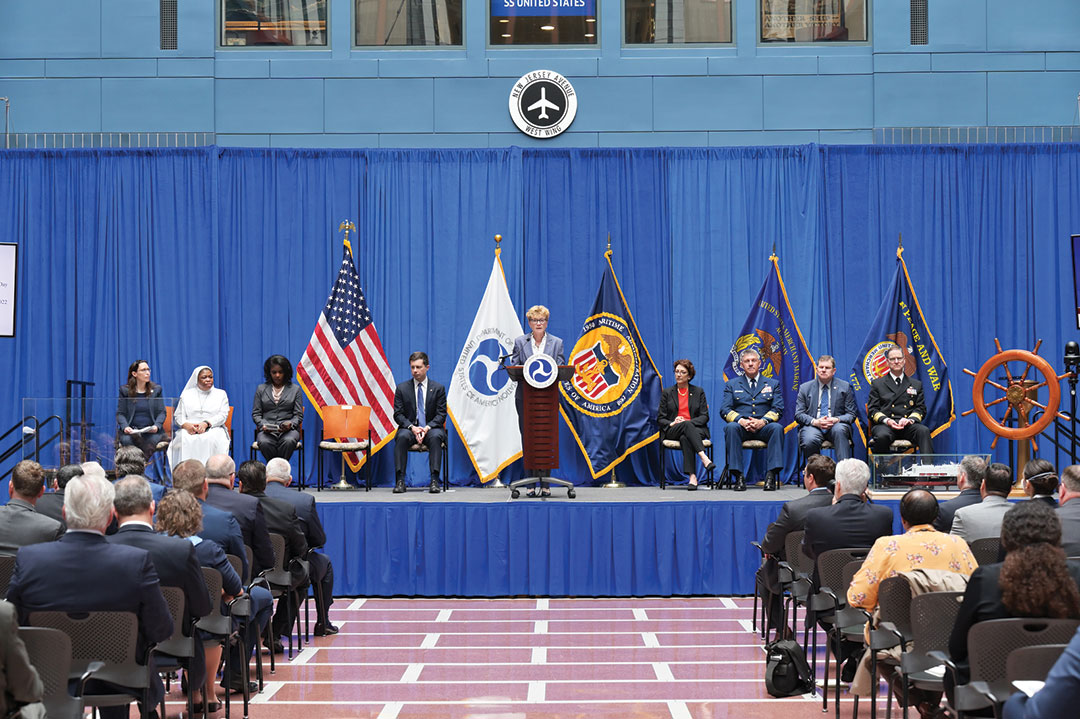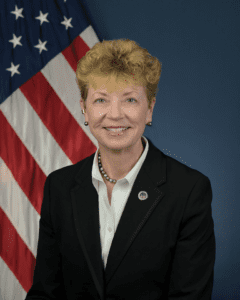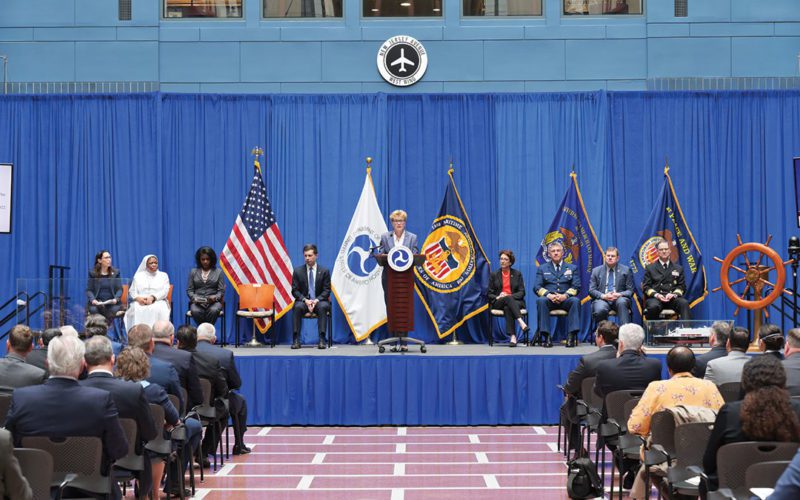 Smoothing supply chain, building port infrastructure and supporting U.S.-flagged fleet are other top priorities
Smoothing supply chain, building port infrastructure and supporting U.S.-flagged fleet are other top priorities

America’s maritime industry must adapt and change to retain its current workforce and attract a new generation of mariners, according to the new leader of the U.S. Maritime Administration (MarAd).
Although that responsibility lies with the operators themselves, U.S. Maritime Administrator Ann Phillips believes MarAd can nudge industry in the right direction when it comes to improving shipboard culture. That includes everything from promoting better conditions to aggressively targeting sexual harassment and assault at sea.
“MarAd’s responsibility is to acknowledge the need in some cases for a culture change within the workforce,” she said in an interview. “In that context, I am talking more about how mariners are treated at sea.”
“If the workforce doesn’t feel they will be treated fairly,” Phillips added, “why would they work in this industry?”
President Joe Biden tapped Phillips to lead MarAd last fall, and she was sworn in in May. She came to the agency after a 31-year career in the U.S. Navy, during which time she rose to the position of rear admiral. In her final tour of duty, she commanded Expeditionary Strike Force Group Two, a role that included direct oversight of 14 ships and 10 subordinate commands, according to a biography shared by MarAd.
Phillips spoke to Professional Mariner for 30 minutes in late July. It was her first media interview since taking the position. At that point, she had been on the job for barely two months.
In that time, MarAd convened meetings to hear from industry stakeholders focusing on rooting out sexual harassment and assault at sea. The effort took on new urgency last fall following the publication of an online essay by U.S. Merchant Marine Academy (USMMA) cadet Hope Hicks under the name Midshipman X.
Hicks’ detailed account of sexual abuse during Sea Year training shook the industry and got the attention of Congress. MarAd paused Sea Year training for about six weeks, and in that time developed a new framework aimed at stamping out sexual abuse and harassment across the maritime industry. The new framework, known as EMBARC (Every Mariner Builds a Respectful Culture), began in December 2021.
It’s a task that has been addressed before, most notably after the 2016 Sea Year stand down. Phillips believes this time could be different. EMBARC requires shippers that take USMMA cadets on board to agree to sweeping rules to prevent sexual harassment and assault, and stipulates how mariners should respond when it happens.
As of late July, 10 U.S.-flagged carriers had signed onto EMBARC, which builds the sexual harassment and assault standards into the vessel’s safety management system. As such, outside auditors will routinely gauge the effectiveness of the program and how closely it is being followed.
“There are more teeth to it,” Phillips said of EMBARC, which aims to change the culture aboard America’s oceangoing ships. “It is the connection to the safety management system that is those teeth.”
Phillips credited Deputy Administrator Lucinda Lessley with developing EMBARC rules during her tenure as acting MarAd administration. MarAd is working on updates to EMBARC that are driven in part by discussions with industry and maritime unions. Phillips said the “EMBARC 2.0” framework will build on the strengths of the existing program. The updates are tentatively scheduled for release within a year.
Broadly speaking, she suggested there is a connection between rooting out this kind of abuse at sea and bolstering the maritime workforce. She believes operators have a vested interest in making their profession inviting, particularly to women, as labor shortages continue to challenge American businesses.
Phillips noted that women represent nearly half of the American workforce but only a fraction of the maritime workforce. In that sense, they represent a real opportunity for operators to fill workforce needs in the short and long term.
“If you want to go after a robust workforce and you are only going after half the available people, then you are missing out,” she said, noting that she is by no means an expert on labor or employment.
“At this time, when we need people more than ever and need to build this industry more than ever, we need bright young minds,” she said. “We can’t afford to have them think this will happen to them, or have it happen to them.”
Phillips was quick to note that sexual harassment and abuse is not limited to women within the maritime industry.
Beyond that issue, the agency is working to promote the maritime industry to young people. Phillips touted MarAd’s Centers of Excellence (CoE) designation that recognizes some of the top training programs in the nation. In May 2021, 27 centers in 16 states received the first CoE designations. Applications for the second round of CoE can be submitted through Sept. 19.
“Our collaboration with these institutions represents an important expansion of MarAd’s role in supporting maritime education and will help form pathways to good-paying American jobs in our nation’s maritime industry,” U.S. Transportation Secretary Pete Buttigieg said last spring.
MarAd is officially an agency within the U.S. Department of Transportation. It is tasked with promoting and supporting America’s waterborne transportation system. As such, its reach extends well beyond the maritime workforce. Right now, much of its attention is focused on allocating more than $2.25 billion in Port Infrastructure Development Program (PIDP) grants allocated through the $1.2 trillion bipartisan infrastructure package. The law will allocate $450 million in PIDP funding each year through 2026.
MarAd is currently reviewing grant requests for this year’s PIDP funding, which also includes $230 million in funding allocated separately. Awards will be issued this fall, followed soon afterward by another funding round. Phillips described it as a generational opportunity to improve America’s ports.
The infrastructure package also contained $25 million in new funding for America’s Marine Highway Program (AMHP) in addition to nearly $15 million in funding allocated separately by Congress. The money will support ongoing efforts to transport more cargo by water, thereby reducing emissions and highway congestion. The latest AMHP projects were announced in June.
The U.S. maritime industry represents an important part of the American economy. It also supports the nation’s security. MarAd is moving to expand on those capabilities with the creation of a 10-ship Tanker Security Fleet comprised of U.S.-flagged tankers. Congress has authorized $60 million a year between 2022 and 2035 to support this program.
The program is currently in the rulemaking stage, and Phillips hopes to have that process finalized by next summer. “It has been a long time in the making, and we are now in a place where we have funding and we want to move forward as quickly as possible,” she said.
Looking ahead a year, she wants to see ongoing efforts to build mariner training capacity within the United States. She also wants to see most U.S.-flagged carriers enrolled in the EMBARC program. Phillips also expects to see the first national security multi-mission vessel (NSMV) delivered from Philly Shipyard to its destination at SUNY Maritime.
Phillips spent her first two months acclimating to the new position and holding meetings with industry leaders. She described a juggling act that involves supporting ongoing programs and continuing to advocate for the maritime industry on Capitol Hill.
“It is an honor to be in this position,” she said. “I understand the vital nature of this work and I am thrilled to be a part of it.”

